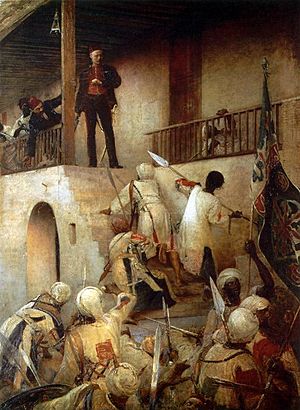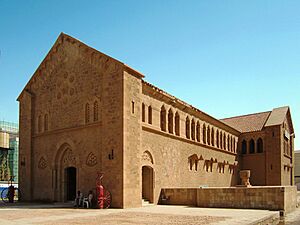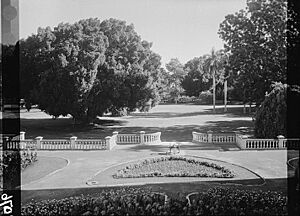Republican Palace, Khartoum facts for kids
Quick facts for kids Republican Palace |
|
|---|---|
|
القصر الجمهوري
|
|

The Old Republican Palace in 1940
|
|
| Former names | Hakimadaria Palace (1828 – 1885) Governor-General's Palace (1900 – 1956) Republican Palace (1956 – 1971) People's Palace (1971 – 1985) Republican Palace (1985 – 2015) New Republican Palace (since 2015) |
| General information | |
| Type | Presidential Palace |
| Architectural style | English Palladian architecture (Old Republican Palace) Islamic architecture (New Republican Palace) |
| Location | Nile street |
| Town or city | Khartoum |
| Country | Sudan |
| Coordinates | 15°36′33″N 32°31′40″E / 15.60917°N 32.52778°E |
| Completed | Hakimadaria Palace (1825 – 1828; 3 years) Governor-General's Palace (1899 – 1900; 1 year) New Republican Palace (2010 – 2015; 4 years) |
| Opened | Hakimadaria Palace (1828 – 1885; 57 years) (Old) Republican Palace (1900) New Republican Palace (26 January 2015) |
| Owner | Turkish Sudan (1828 – 1885) Anglo-Egyptian Sudan (1900 – 1955) Government of Sudan (since 1956) |
| Grounds | 150,000 m2 (1,600,000 sq ft) |
| Other information | |
| Facilities | Republican Palace Museum Republican Guard HQ General Gordon's Last Stand's staircase |
The Sudanese Republican Palace (Arabic: القصر الجمهوري, al-Qaṣr al-Jumhūriy) is the official home of the President of Sudan. It is located in Khartoum, the capital city. The complex includes the Old Republican Palace built in 1830 and the New Republican Palace finished in 2015. This palace is very important to Sudan's history and culture. While the palace itself is not open to visitors, there is a museum behind it that you can explore.
The Republican Palace is a strong symbol for Sudan. You can see its picture on postage stamps and banknotes. The main street leading to it is even named after the palace. It is one of Khartoum's most famous buildings. It sits on the southern bank of the Blue Nile River, close to where the Blue and White Niles meet.
Important ceremonies happen here. For example, new ambassadors from other countries present their official papers at the palace. Many historical events have taken place at the Republican Palace. These include the death of Charles George Gordon, a British ruler, during the Turco-Egyptian colonisation of Sudan. It also hosted the first celebration of Sudan's independence in January 1956. On that day, the flags of the colonial rulers were lowered, and the flag of the Sudanese Republic was raised.
Contents
Where is the Republican Palace?
The Republican Palace complex is on the south side of the Blue Nile river. Nile Street borders it to the north. University Avenue is to the south. Abusin Street is to the east, and Mihera Bint Abboud Street is to the west. City planners designed the palace to divide Khartoum into two parts. Government buildings, offices, and businesses were built around it.
A Look at the Palace's History
Sudan came under Turkish-Egyptian rule in 1821. This happened after Muhammad Ali Pasha took control. During this time, Egypt governed Sudan. A ruler called the Hakimadar was in charge. Khartoum became the capital of Sudan in 1830. This was a big step in the country's history.
The First Palace: Hakimadaria Palace
The first palace was built between 1825 and 1828. It was made of mud and shaped like a rectangle. This building was the main office for Sudan's government. It was located on the southern bank of the Blue Nile. It was less than a kilometer from where the White and Blue Niles join. The palace was called Saray al-Hakimadaria or Hakimadaria Palace. The Hakimadar lived there. The word "Saraya" means "castle" or "palace."
In 1834, the Hakimadaria Palace was improved. More buildings were added for government offices. The Hakimadar continued to live in the palace.
In 1851, the mud palace was torn down. A new one was built using bricks. These bricks came from old cities like Soba. The new palace had two floors and was made of stone on the outside. It had gardens with palm trees and grapes. The Hakimadaria Palace remained the Hakimadar's home until the Mahdist revolution.
The palace had three parts: a ground floor and two upper floors. The Hakimadar's offices were on the second floor. His assistants worked on the ground floor. The first floor was his home. Later, in 1884, Charles Gordon, the Governor-General, changed this. He moved his home to the second floor and his office to the first.
On January 26, 1885, Charles Gordon was killed at Hakimadaria Palace. This happened during the siege of Khartoum. After this, the Hakimadaria palace was destroyed. The capital was moved to Omdurman. Omdurman remained the capital until the Anglo-Egyptian colonisation.
The Governor-General's Palace
From 1898 to 1955, Sudan was ruled by Britain and Egypt. Khartoum became the capital again. The first governor-general, Herbert Kitchener, rebuilt the palace in 1899. It was built on the same spot using stones from the old palace. By 1900, much of the palace was ready. The second governor, Reginald Wingate, moved in. The rest of the palace was finished by 1906.
The palace was built with red bricks and sandstone. Its design was like Victorian architecture. It also had Middle Eastern touches with arched doors and windows. The palace had three floors. The ground floor held offices. The first floor was for the Church of England. The third floor was the governor-general's office.
This palace became the main home and office for the governor-general. It stayed that way throughout the Anglo-Egyptian rule. The palace grounds grew to cover about 74,000 square meters.
The (Old) Republican Palace
On January 1, 1956, Sudan became an independent country. The British and Egyptian flags were lowered at the palace. The Sudanese flag was raised. The palace was then called the Republican Palace. It became the official home for the President of Sudan. It also housed offices for the Sovereignty Council.
The second floor of the palace was used as a guesthouse. Important leaders from other countries stayed there until 1974. In 1960, a residence was built for former President Ibrahim Abboud. He was the only Sudanese leader to live inside the palace. In 1971, more buildings were added. These were for palace departments, the Republican Guard, and car parking. The palace area grew to 150,000 square meters.
The People's Palace
President Jaafar al-Numeiri changed the palace's name to the People's Palace in 1971. He said the people supported him after a failed attempt to remove him from power. However, after Nimeiri was overthrown in 1985, the palace was renamed the Republican Palace again.
An Old and Important Building
The old Republican Palace building is considered an important historical site. This is because it is over 100 years old and has special historical meaning. Laws protect it from being changed or sold without permission. The building also used materials from the ancient Christian kingdom of Alwa. This makes it even more historically valuable.
The New Republican Palace
During a visit by Chinese President Hu Jintao in 2007, an agreement was made. They decided to build a new presidential palace. The design contract was signed in 2009. Construction began in March 2011. On January 26, 2015, the new palace was officially opened. This was the same day Charles Gordon was killed at the old palace. President Omar al-Bashir raised the flag over the new palace. This marked the move to the new location.
Some people were concerned about the new palace. They felt it changed the look of the historical area. The new building has an Arabic style. This is very different from the old palace's English Palladian architecture. The palace garden, which was part of the original design, was also affected.
Damage During the 2023 Conflict
During the War in Sudan (2023–present) in April 2023, the Rapid Support Forces (RSF) took control of the Republican Palace. In May, the RSF said the Sudanese Armed Forces (SAF) attacked the old palace with missiles. The SAF denied this. Pictures showed the new palace was badly damaged by fire. In August 2023, the SAF launched more attacks on the palace. In May 2024, the SAF attacked the old palace again, causing parts of it to catch fire.
What's Inside the Palace Complex?
The Republican Palace is important for Sudan's history and culture. While the palace itself is not open to the public, there is a museum behind it. The main street leading to the palace is named after it. The palace is a major landmark in Khartoum. It sits on the Blue Nile, near where it meets the White Nile. It overlooks a small square, once called "Palace Square," now known as Martyrs Square.
The Republican Palace complex includes the New Presidential Palace (5,300 square meters) and the Old Presidential Palace (1,926 square meters). It also has other important areas:
The President's Office
The office of the President of Sudan is located here. Past rulers of Sudan used this office. After independence in 1956, it became the President's office. Many presidents, including Ismail Al-Azhari and Omar Al-Bashir, have used this space.
The Vice President's Office
This office is on the ground floor. In the past, it was for the rulers' assistants. After Sudan became independent, it became the office for a member of the Sovereignty Council. Later, it became the Vice President's office.
The Republican Guard Headquarters
The palace has a special military group called the Republican Guard. They protect the palace and perform ceremonial duties. For example, they organize parades for visiting leaders. They also stand guard at the palace gates. The Republican Guard was formed on October 15, 1960.
Administration
The palace is managed by the Ministry of Presidential Affairs. This ministry has different departments. These include Protocol, Information, Legal Affairs, and Financial Affairs.
Guest Residences

The residential areas are on the second floor. They have a large hall, bedrooms, and dining rooms. In the past, rulers and their families lived here. After independence, it became a place for visiting heads of state. Famous guests include Queen Elizabeth II in 1965. Emperor Haile Selassie of Ethiopia and Egyptian President Gamal Abdel Nasser also stayed here.
Meeting Rooms
After the palace was rebuilt in 1900, one hall became a small church. Later, it was changed into a meeting hall. This is where important discussions take place.
Another hall was once used for official dinners. In 1977, it became a hall for press conferences. It is now used for both official meetings and press conferences.
The Palace Flagpole
The flagpole is on the highest roof of the palace. When the palace was first built, it had one pole. This pole flew the Turkish-Egyptian flag. This flag showed the Ottoman Empire's rule over Sudan.
After the palace was rebuilt in 1900, there were two poles. They showed the joint British and Egyptian rule. One pole flew the Egyptian royal flag. The other flew the British Union Jack.
On January 1, 1956, a third pole was added. The old flags were lowered. The flag of Sudan's independence was raised on the middle pole. This blue, yellow, and green flag showed Sudan's new freedom. The other two poles were left empty. This symbolized the end of colonial rule in Sudan.
General Gordon's Last Stand Staircase

This staircase is very famous. It appears in a painting by George W. Joy. The painting shows the death of Gordon Pasha. Gordon was the Governor-General of Sudan. He was killed on these stairs on January 26, 1884. This happened when Mahdi supporters attacked Khartoum. His death marked the end of Turkish rule and the start of the Mahdist state.
When the palace was rebuilt in 1900, the British rulers took great interest in this staircase. Many visitors still want to see it because of its historical importance.
The Palace Museum
The Republican Palace Museum is inside the palace walls. It is located in the southeastern part, facing University Street. The museum building was once an Anglican Cathedral. It was built in 1912.
The museum building itself is a historical artifact. It shows Byzantine architecture. The museum displays many items. These include cars used by Sudan's rulers. There are also paintings, photographs, and gifts given to presidents. You can see musical instruments, dishes, and furniture from past eras. The museum opened on December 31, 1999. It is one of the few parts of the complex open to the public.
Gardens
The palace gardens are very old. They were created when the first palace was built. Many improvements were made, especially by General Kitchener. He brought experts from Europe to develop them. The gardens have many different plants and trees. Some trees, like the "Mango Kitchener," were brought from other countries. The garden covers about 50,000 square meters.
Library
The palace has a library with many books. In 1976, it was decided to collect all the books in the palace. They were put into a special room. More books were added in 1988 and 2006. The library was later moved to a new location. It now has a reading hall for visitors. It also has an archive for storing and displaying documents. The library is open to the public.
Mosque
A mosque was built inside the Republican Palace. It is located in the southeastern part, near University Street and Martyrs Square. The mosque is open to the public during prayer times.
Why is the Palace Important?
The Republican Palace is the official home of the president. It is also used to welcome important guests. Many world leaders and diplomats have visited the palace over the years. It is a strong political symbol for Sudan. Official ceremonies and meetings with foreign ambassadors happen here. Its image has appeared on stamps and banknotes.
The palace has been the site of many historical events. These include Sudan's independence and the raising of the new flag. In 1969, a military coup took place here. General Gaafar Nimeiry came to power. In 1985, another military coup happened. This one removed Nimeiry and brought in a civilian government.
The palace has also hosted important international meetings. For example, the Arab League summit in 1967 was held here. This meeting is famous for the "Three No's" resolution. This resolution stated: "No peace with Israel, no recognition of Israel, no negotiations with Israel."
In April 2019, the Sudanese military overthrew President Omar al-Bashir. The palace has since been controlled by different transitional governments. In April 2023, during the 2023 Sudan conflict, the Rapid Support Forces (RSF) took control of the Republican Palace. The RSF is a powerful military group in Sudan.






